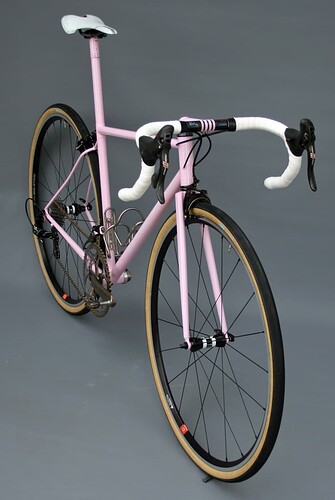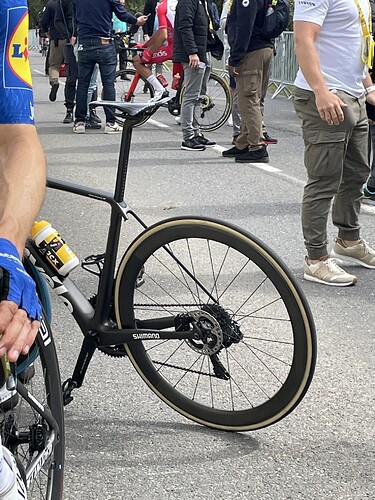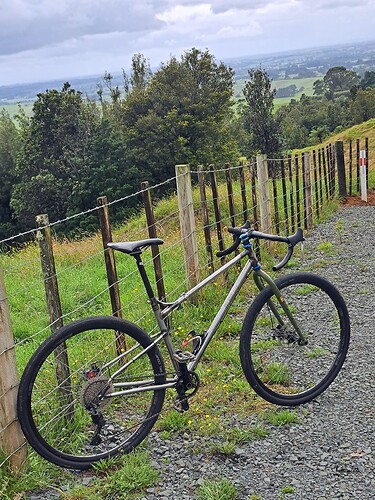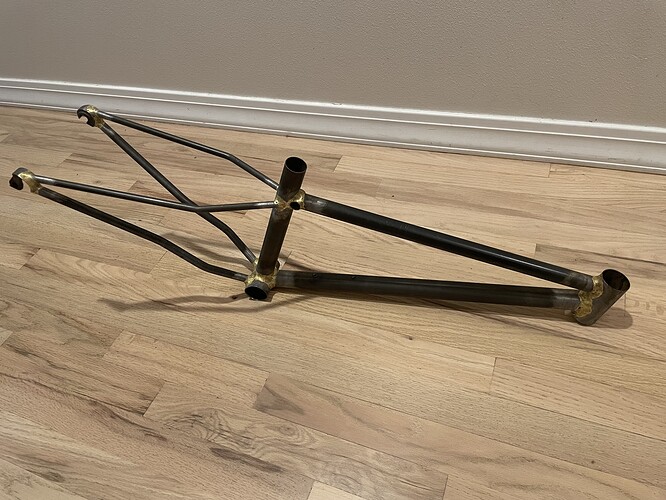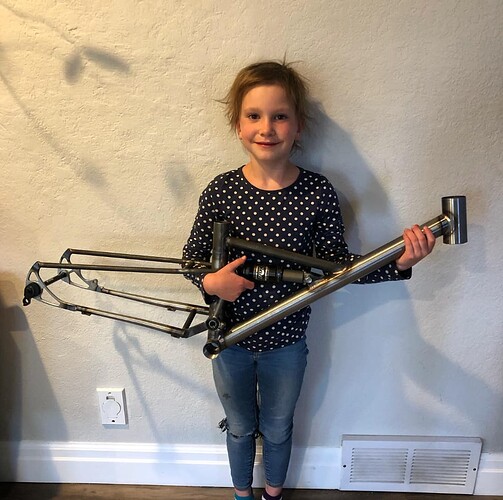I’ve been working on a road-ish bike design for an upcoming small batch production run. It’s meant to be pretty light & flexy with “standard diameter” tubesets in the small & medium sizes. I’d like to keep that flexibility through the smaller (XS-XXS) sizes as well. Can anyone here speak to using 22.2mm tubing as a top tube and 25.4mm as a down tube? I can’t imagine this hasn’t been done before, but I’m having a hard time finding information on it.
That is an interesting question. We just finished a prototype gravel bike for 115lb-ish 5’3ish rider:
It has a 25.4TT and 31.8DT. I have no idea if that is too much or too little, we still need to build up the bike to collect feedback. I really have no idea!
One feedback that we got on XXS mountain bikes is the stiff rear ends. Our testers didn’t notice the difference between a 32mm DT and a 35mm DT, but felt the compliance of +5mm CS and .5in seatstays. My intuition says for smaller frames, the rear triangle of the bike has a bigger impact than the front triangle. For mountain bikes, I attribute it to the 35mm seat tubes (for dropper posts).
Just wondering out loud, for small road bikes, maybe the 25.4 seatpost would give more seatpost flex and frame flex.
The 25.4 seatpost standard seems reasonably supported by Enve, Thomson, Zipp, and older Cannondales
No idea what seat tube you would need to use with a 25.4 Seatpost. I guess you would still need to use a 28.6 ST with a welded-on topper, so you don’t get any more frame compliance…
That makes total sense! The main triangle tubes don’t contribute nearly as much to ride feel as the rear triangle (atmo). I was also thinking about doing 15.9mm CS & 9.5mm SS for the XS/XXS to increase compliance but that might be pushing the envelope a bit much. I’m also worried about making assumptions about rider weight and going too far in the noodle direction.
The 25.4mm seatpost is an interesting thought! I’m also hoping to maintain compatibility with 27.2mm droppers so can’t do that on this bike but it’s something I’d like to research more.
I found it really hard to simulate rear triangles with FEA, so it’s hard to say. However, with thru-axles, I think we underestimate the rigidity of the rear triangle. 9.5mm SS’s might be totally fine (and look really cool).
This English is super cool: https://cyclingtips.com/2020/08/bikes-of-the-bunch-rob-englishs-english-road-bike/
I wanted to try undersizing the tubing a little from what I usually use, to see how that felt for ride quality. For my personal bikes — as a 140 lb, 5’9″ (64 kg, 175 cm) rider — I have generally been using a 35 mm down tube, ovalised 28.6 mm top tube, 28.6 mm seat tube, ovalised 24 mm chainstays and 9.5 mm seatstays. For this one, everything went down one size, so the down tube is 31.8 mm (bi-ovalised at the BB), ovalised 25.4 mm top tube, 25.4 mm seat mast, ovalised 22 mm chainstays and 8 mm seatstays.
There is this funny example:
“Standard” diameter road tubing makes sense for the smallest frame size - and a skinny flexy seatpost would compliance - I’d simply use a seatpost sleeve like the Cane Creek 25.4 - 27.2 to fit the seatpost, it’s invisible under a binder clamp.
And if you look at the mega-skinny rear ends that Rob English is putting out there, I wouldn’t be concerned about skinny seat stays for light riders on XXS frames. The chainstays have to be up to the job of supporting the flat mount brakes but the seatstays are under compression and don’t do a whole lot.
I recon the difference in compliance with the +5mm chainstays probably has nothing to do with flexibility and everything to do with getting the bb further from the rear axle. Ever ridden in a bus/van in the back right over the rear axle vs in the middle of the wheelbase? I mean I don’t really know but that’s what my intuition would suggest.
My road/allroad bike has 31.8dt and 25.4tt, both .9mm straight gauge and I do stupid stuff like wheelies and riding down stairs and generally abuse it and it hasn’t broken yet. It’s still young though so there’s plenty of time. I weigh 82kg. It doesn’t feel noodly to me but not exactly stiff either.
I want to make a road bike for my wife soon and was also considering 7/8" top tube. She would be a lot kinder to her bike than me as well so interested to hear if anyone has first hand experience
I would probably stick with 25.4 TT and 28.6 DT because you’ll have more profile options, including some really thin wall stuff to save weight over straight gage tubing one size down.
Daniel’s idea of using a smaller diameter seat post with lots of exposed post is excellent. You can use a standard ST for 27.2 and shim it.
You can likely use 3/8" seat stays but I wouldn’t undersize the chainstays if you’re using flat mount. I regularly use 1/2" seat stays on hardtails and gravel bikes for average to slightly above average sized men.
Not quite what you’re looking for, but: This is a 20” wheeled bike which uses a 22.2 x .9 straight gauge TT, with a 28.6 double butted DT, and a straight gauge 28.6 ST that fits a 26.8 seat post. Seat stays are 3/8” x .028 and chainstays are 12.7 x .9. Weighed 3 lbs. She’s pretty a light rider, so it hasn’t broken yet. I wouldn’t let anyone over 75 lbs on that bike though. When I built it, I think I did the volume calculations and 22.2 straight gauge was lighter than a butted 25.4 IIRC.
She grew a lot in the last 18 months and I’m currently working on the 24” wheel version. Front triangle uses exactly the same tubes with a slightly beefier rear end.
FWIW, I’ve built small adult sized MTBs with 25.4 butted TTs and 31.8 butted DTs with no problems.
I wouldn’t have a problem building an XXS frame for an adult with a 22.2 TT. I don’t think it will break, but it starts to look disproportionately small is my only concern.
I’ve done a lot of kids bikes with 5/8"/16mm chainstays (using seatstay material) and 14mm and under seatstays, for what it’s worth.
Kids are not the same as small adults, obviously, though.
IMO the compliance difference is minimal regardless, though. It’s a truss when all is said and done. More seatpost sticking out or less tire pressure or a saddle that isn’t a total ass-hatchet will get you more comfort than anything you can do with the frame tubes.
-Walt
That’s awesome.
I agree with you there. Being a truss it’s the whole frame that will give a little under hard compressions. Not just the front or rear. Thin seat stays possibly do flex/bow out a fraction which takes that edge of but it’s percentage points. Having said that you can feel the slight difference between say a 19mm and 14mm stay. Would be interesting and nice to understand exactly what is going on there. Tire pressure has orders of magnitude more influence.
Out of curiosity, I calculated tube weights for 22.2x.9 vs. 25.4 7/4/7 tange prestige at 436mm length (from Daniel’s drawing). The 22.2 weighs about 206g while the 25.4 weighs about 134g.
For a kid’s bike though it’d probably be better to stick with thicker material. That frame you made her looks rad!
I welded three frames for a 140 lb rider for the 1992 cyclocross season, 1" TT and 1-1/8" DT. I don’t recall wall thicknesses, but it was not easy to weld. The rider really liked the ride quality and how light the frames were, but all three frames broke that season, at the HT/DT. Obviously, CX is harder on a frame than road riding, but be cautious about rider weight and how aggressive they may be.
I’ve been riding a self-made 1" TT/1.125" DT cross style bike for a while now and it’s held up pretty well, even on light mtb trails. I was hoping to push it to failure, but haven’t quite got there yet!
Likewise almost all of my bikes have had 1” top tubes and 1.125” downtubes. I’m not easy on them and they (mostly) don’t break. I did break one that was 7/4/7 tubing, had been in a car/bike accident, and might have been filed a little too much near the DT/HT lug.
I’d rather have these “standard diameter” bikes in 9/6/9 than “oversized” in 7/4/7 because they are a bit more resilient to abuse and provide similar ride qualities. There is a slight weight penalty.
I’ve always felt like small bikes for the sub-5 foot rider should probably use smaller tubes and wondered if 7/8” by 0.028” is a good option with a gusset at the HT.
I’ve noticed that high end kids bikes use very skinny aluminum tubes compared to adult bikes. An Islabike Luath 24 has 32mm TT and 35mm DT and is a cyclecross kids bike meant for kids around 4’4” - 4’10” tall. Those diameters seem to be two sizes smaller than what adult bikes use and would be similar to having a 7/8” top tube in steel.
My 3 year olds Islabike Cnoc 14 has absolutely tiny 28mm main triangle aluminum tubes.
This has me curious if there is a table that shows normal tube diameters for road and mtb use in steel, aluminum, and Ti? That would be handy. I personally really only know steel sizes for road/CX/touring/allroad and have some half formed opinions for steel mtb.
You can’t compare tube diameters bewteen aluminium and steel. Steel is way stiffer so you can use smaller diamteres than aluminium for the same amount of flex. Don’t get fixated on the diameter only, it’s a combination of diameter, wall thickness and length of butting that will determine the overall ride. Tubes with thicker butts will last longer but be stiffer for the same diameter. Weight is a secondary consideration. Sometimes its a nice bonus it ends up at a good weight and sometimes it ends up being a little heavier but is a stellar bike. We all know this.
I don’t think I was clear in what I thought would be helpful.
If I know what a 25.4mm 9/6/9 steel tube rides like what would the equivalent be in aluminum? A long time ago I did all of the beam deflection math (it’s not that complicated) to figure out that a 25.4mm 9/6/9 tube and a 28.6mm 7/4/7 tube have very similar stiffness characteristics, and that has been a useful nugget to keep in my mind.
I’ve never built with aluminum so I don’t know the standard diameters and wall thicknesses. It’s a sidebar for this conversation.
I’ve not built with aluminium either. No interest at all for me so haven’t even bothered with any calculations on it. I do know with the ‘high end’ production aluminium frames from Giant, Scott, Trek etc. the walls were very thin with really big diameters. So thin you could squeeze the tube and see it flex. I do think they were chasing those stiffness targets with those, rather than a quality smooth ride. Part of the stupid industry spiral into the weeds chasing lighter and stiffer to the detriment of ride quality. Because 10% ‘better’ is easier to market than ride quality, which has no metric to measure it by. The fact that Specialized introduced variable tube diameters in their Tarmac range, to ensure the smallest to the biggest frame returned the same ride feel tells you a lot about the importance of it. Of course, custom builders have been doing that forever so it’s not a new thing as much as Spec was trying to tell everyone it’s a cool new feature.
So to answer you thinking about aluminium, like steel it depends on teh bike and it’s intended end use and the availability of tubing to achieve the end goal. Functional design trumps trying to save weight every time in my mind.
Some riders have grace and finesse, you’re one of them!


